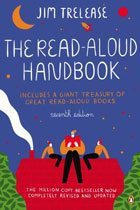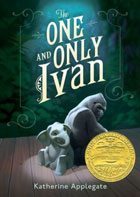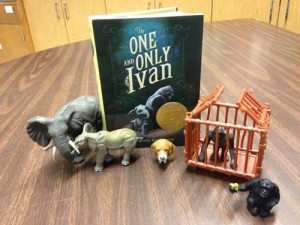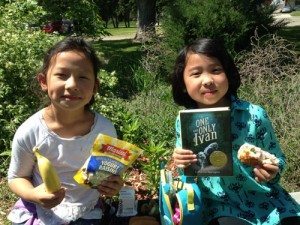by Maurna Rome
I believe whole-heartedly in the importance of reading aloud daily to my students. On days I fail to meet this goal, I go home feeling like I’ve let the kids down. I recall the frenzy of Valentine’s Day with the excitement of school-wide bingo, special class projects and more than enough candy — but no time spent reading aloud. I doubt that the kids left my class thinking that something was missing that day and I am sure no one reported to their parents that their teacher really blew it by not reading to them. Yet it bothered me greatly. It wasn’t the first and won’t be the last day I fall short. However, I am dedicated to making reading aloud a priority in my classroom. I encourage every teacher to join me in making it a goal that students will not miss out on this essential ingredient from our arsenal of literacy best practices.
 More than 30 years ago, Jim Trelease wrote a little book that would become a national best seller, with more than a million copies sold. The 7th edition of The Read Aloud Handbook was released in 2013. It highlights present-day literacy challenges as well as those that have remained the same since 1982. I highly recommend this gem, along with several other “professional books” on this topic by experts I greatly admire: Unwrapping the Read Aloud by Lester Laminack; Igniting a Passion for Reading by Steven Layne, and Reading Magic: Why Reading Aloud to Our Children Will Change Their Lives Forever by Mem Fox.
More than 30 years ago, Jim Trelease wrote a little book that would become a national best seller, with more than a million copies sold. The 7th edition of The Read Aloud Handbook was released in 2013. It highlights present-day literacy challenges as well as those that have remained the same since 1982. I highly recommend this gem, along with several other “professional books” on this topic by experts I greatly admire: Unwrapping the Read Aloud by Lester Laminack; Igniting a Passion for Reading by Steven Layne, and Reading Magic: Why Reading Aloud to Our Children Will Change Their Lives Forever by Mem Fox.
I can guarantee that none of the 9 year olds in my classroom have read any of the texts mentioned above. Chances are that they are also not aware of the recent report issued by Scholastic asserting that we can predict which kids will become our best readers based on how often they have benefitted from being read to.
However, when I recently challenged my students to write a letter to teachers everywhere about the importance of reading out loud to kids, they seem to have hit the nail on the head. Here is a sampling of their wisdom and insight:
- I think it’s a good idea because every student will be wondering every time you read.
- Your students might learn new words that they don’t know.
- It’s a good idea to read chapter books to your students because they can see pictures in their minds.
- Chapter books are full of adventures.
- They can relate with something they did or something one of their family members did.
- They can be better writers.
- If it’s a funny chapter book, you will get a laugh out of it.
- It gives kids ideas and more imagination. It might make kids want to read even more.
Laminack has identified six types of read alouds that offer teachers a sure fire way to accomplish the following: support standards, model the process of writing, build vocabulary, encourage children to read independently, demonstrate fluent reading and promote community. As I reflect on the responses from my students, I see that all six purposes are mentioned. I am convinced that the very best books for reading aloud are able to incorporate all of the above. What a powerful approach to making an impact on literacy achievement!
 Last week we finished the unforgettable 2013 Newbery Award winner, The One and Only Ivan, by Katherine Applegate. Here is a peek at how this touching story played out in Room 132.
Last week we finished the unforgettable 2013 Newbery Award winner, The One and Only Ivan, by Katherine Applegate. Here is a peek at how this touching story played out in Room 132.
Supporting the standards: See the following examples and notations.
Modeling the process of writing: Using the six “sign posts” from Notice and Note by Kylene Beers and Bob Probst, we are always on the lookout for techniques the writer uses to tell the story. While reading Ivan, we have discovered that “tough questions”, “again and again”, and “words of the wiser” are woven throughout the story. Kids are now beginning to work these same elements into their own stories!
CCSS.ELA-LITERACY.W.3.3.B Use dialogue and descriptions of actions, thoughts, and feelings to develop experiences and events or show the response of characters to situations.
Building vocabulary: During each read aloud session, a student serves as the “word recorder”. Students are encouraged to listen carefully and hold up their thumb anytime they notice a special or fancy word in the text. We talk about those words and the word recorder makes a list of all the words we discuss. Once we had over 30 words, each student selected one word, painted it on poster sized paper (as Ivan would have done) and then drew a picture to show the definition.
CCSS.ELA-LITERACY.RL.3.4 Determine the meaning of words and phrases as they are used in a text, distinguishing literal from nonliteral language.

Encouraging students to read independently: As with all of the books I read out loud in the classroom, students are eager to check out that very same title from the library. Those that are lucky enough to get their hands on the book bask in the light of knowing what is yet to come in the story. They keep the promise of not spoiling things for their peers, as they are clearly motivated to read ahead on their own.
CCSS.ELA-LITERACY.RL.3.10 By the end of the year, read and comprehend literature, including stories, dramas, and poetry, at the high end of the grades 2 – 3 text complexity band independently and proficiently.
Demonstrating fluent reading: To show my students what smooth oral reading sounds like, I emphasize the voice of each character. While reading The One and Only Ivan, Ruby is represented with a 5 year-old little girl voice, Ivan has a deep voice and Bob takes on a more sarcastic tone.
CCSS.ELA-LITERACY.RF.3.4 Read with sufficient accuracy and fluency to support comprehension.

Promoting Community: The well developed characters from our read aloud stories become new friends to us. We talk and think about them as if they are actual members of our classroom, with lines such as “What would Ivan do?” or “Remember when Ivan …” One rainy day during inside recess, the kids playing with our plastic animal collection proudly set up a display of “Ivan” characters; Stella and Ruby the elephants, Bob the dog, Ivan and his sister, Not-Tag, the gorillas, were all arranged to reenact a scene from the book. It struck me that my students really are mindful of the characters we grow to love and admire. I stopped everything to draw attention to this sweet gesture and once again, my heart fluttered all because of a great book. This little pretend group of friends remained intact until we finished the book and celebrated with a “Lit Lunch” featuring yogurt covered raisins and bananas!
Yes, an effective read aloud can pack a lot of literacy into a short amount of time, yet I know it is often one of the first things that goes when the schedule gets too full. If you need more convincing to keep the read aloud front and center, consider what this young lady has to say…
Dear Teachers of Every Grade,
You should read to your students because they will be better readers and writers and learn faster and they will be ready for the world!
Love,
Ashley
Looking for resources to help you plan for successful read alouds in your classroom?
Finding the best of the best books to read aloud:
Bookstorms on Bookology
Teacher’s Choice from ILA
Children’s Choice from ILA
Nerdy Book Club Awards

This is a beautiful, must-read essay. I’ll be sharing it all over the place. Thanks, Maurna, for readying your students to be thoughtful, compassionate citizens of the world.
Thank you for your kind words, Tricia, and you are very welcome! My students and I just finished reading “El Deafo” and the conversations we shared surrounding that book were so lovely. I am one lucky teacher!